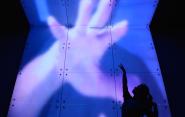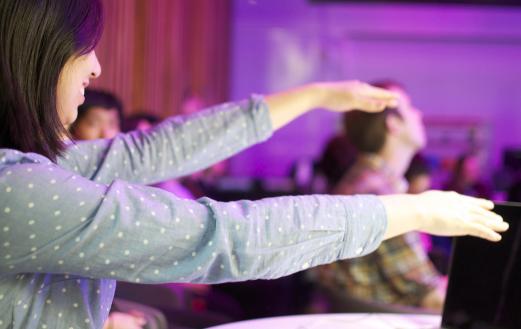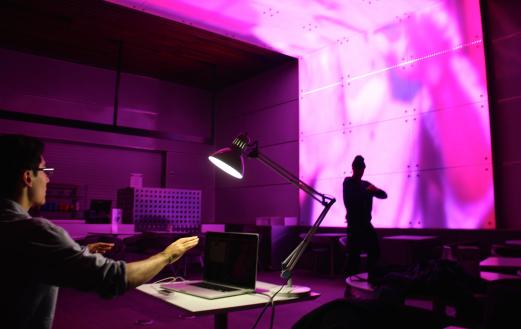Yalie uses computer science, dance to display beauty of everyday movement

Yale senior Sho Matsuzaki sure knows how to throw a party: hypnotically dazzling lights, ever-evolving musical beats, and dancers who put Shakira’s entourage to shame. But this “party” was in fact Matsuzaki’s senior project, a blend of artistry and technology performed April 6 as the capstone for his Computing and the Arts major.

The concept is simple: A live dancer grooves in the middle of Ground, the café at Becton Engineering Center, framed by the expansive 23,000-node LED canvas wrapping around the café’s wall and ceiling. The LED canvas displays a live video stream of an audience member using simple hand gestures to simultaneously control every technological parameter of the performance: As this DJ-like “manipulator” moves and poses her hands in front of the camera, she triggers changes in the musical texture and speed, and the lights on the LED screen change color and intensity. Making a fist, for example, might cause the song’s baseline to become more prominent and might turn the LED lights blue instead of pink.
“The result is a call and response between the manipulator and the dancer,” says Matsuzaki, who worked with members of his dance team, Rhythmic Blue, for the performance. “If the manipulator makes a gesture, the dancer can try to predict what the audio-visual effect will be, complementing and contrasting movements based on what the manipulator does.” So the dancer might emphasize the consistent rhythm of the baseline as it gets louder, instead of matching his or her choreography to the more rhythmically-erratic melody.
Matsuzaki’s project illustrates a conversation between art and science and his performance anticipates the April 9 arrival at Yale of a celebrated master of this kind of blend. Renowned light sculptor, technological innovator, and Yale alum Leo Villareal delivers the 2014 Victor M. Tyler lecture on art and technology on Wednesday at 4:00 p.m. at Sheffield-Sterling-Strathcona Hall.
Like Villareal, Matsuzaki writes the computer programs that serve as the foundation of his art. And like Villareal, the Yale senior uses cutting-edge computer science to give form to abstraction. His custom software successfully interfaces with the camera that records the manipulator, the audio effects processor, and the LED canvas.

But where Villareal—famous for, among other projects, The Bay Lights LED installation on San Francisco’s Bay Bridge—utilizes the abstractions of patterns of color and light, Matsuzaki’s focus is on the physical beauty of the body, highlighting both the dancer and the audience member controlling the music and lights.
“People look at freestyle dance as something that’s very impressive, and they’re wowed that dancers are able to come up with these things. But in reality, we all do similarly complex things with our hands all the time, and I want to create a space where people become aware that their gestures are inherently beautiful,” says Matsuzaki. “Technology that can show us an integral part of the human experience in such a way, that’s the technology that is changing the world.”
For more information about Leo Villareal’s 2014 Victor M. Tyler Lecture, visit the School of Engineering & Applied Science’s events calendar.

